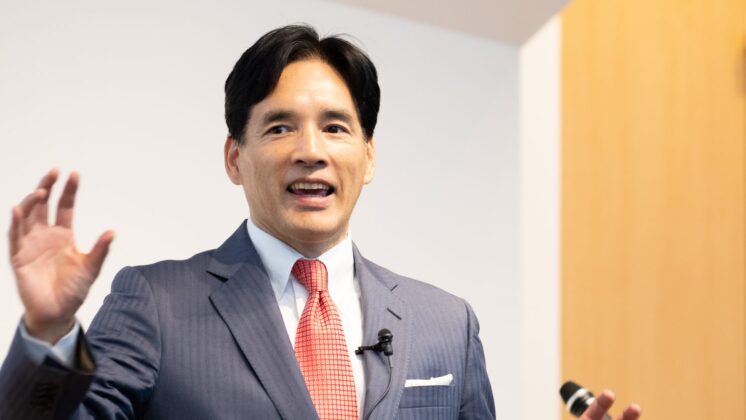Ten of us shared the bus to Nekoma Ski Resort. Three of us went snowboarding. There was such a blizzard! This is a picture taken during a break between snowboarding.
After snowboarding, we headed for an onsen. Following a short meeting with staff members, I waited for other participants to arrive at the reception. The picture is me with my staff member (Ms. Murao), who has helped at the Summit for five consecutive years, and Mr. Hoshino. What we are holding is a handmade tote bag by ICHIZAWA SHINZABURO HANPU. The bag is given only to those who have participated in the Summit for five years in a row. Five stars are printed on the bag like a signature.
The theme of the breakout session D was “Action Statement I: Utilization of Women’s Labor―In Pursuit of New Social Frameworks―.” Ms. Etsuko Okajima, Ms. Naoko Banno, Ms. Yumiko Kamada of East Japan Railway Company (JR East), Ms. Meyumi Yamada of istyle and Mr. Yoshihisa Aono of Cybozu appeared on the stage.
My friends are gathering for the G1 Summit in Urabandai one after another. Just a little while ago, Mr. Kenichiro Mogi and Governor Furukawa of Saga Prefecture arrived. I know that Mr. Shinjiro Koizumi, Mr. Taro Kohno, Mr. Kaname Tajima and Mr. Masaaki Taira are currently on the bus from Koriyama. However, as the highway is closed due to the snowstorm, it is likely to take some time for them to arrive. I assume this will probably provide them an opportunity to talk with one another.
A picture of Mr. Hoshino, Mr. Koizumi and myself.
At the reception, the teams for a snowball fight were announced. Team Tamesue looks strong. Other team leaders are Mr. Inoue of Aoyama Flower Market, who is a triathlon athlete and Mr. Hoshino of Hoshino Resort, who used to play ice hockey at Keio University’s athletic club. The least promising team may be Team Hori, which will be led by me who is only good at swimming and has not much to do with track and field or winter sports.
We went to sleep early that night to be prepared for the snowball fight the next day.
We got together at 9:00 a.m. and started with the snowball fight tournament. You may think it is just a snowball fight, but it was not about just throwing snowballs. Actually, the snowball fight tournament was conducted based on international rules as a sport. Each team consists of seven members and matches are decided by the best of three points in three minutes. Teams either steal the flag or hit more opponents to win the game.
The snowball fight tournament in the morning just finished. In a round robin tournament, Team Hori won. In the tournament based on initial rules, Team Hoshino won. The snowball fight, which originated in Japan, has become a sport with global standardized rules. As it is so much fun, I strongly recommend you to try snowball fighting using the official rules.
After the snowball fight, participants enjoyed an onsen and then headed for the ”Regional Synergy” luncheon. The luncheon was attended by three governors and five mayors. The purpose of the luncheon was to create various kinds of synergy through interaction between heads of local governments and senior executives in the private sector.
Following the ”Regional Synergy” luncheon, the opening ceremony was held. I gave the opening remarks as described in detail in my previous column. (Column: The 5th G1 Summit: 1) Opening Remarks)Then, President Hoshino stepped onto the stage and introduced video footage of the snowball fight.
Now, the first session of the plenary entitled “Expectations for the New Government and Actions by the G1 Summit” has started. We received a video message from Prime Minister Shinzo Abe at the beginning. Thank you, Prime Minister! Your message was really inspiring.
This session was supposed to be between Mr. Heizo Takenaka and Mr. Hiroshige Seko. However, as requested by Mr. Takenaka, I made a last-minute decision to be on stage (although I had been requested to do this unofficially in the past.)
At the beginning of the session, I received questions on the World Economic Forum in Davos (Davos Forum). For me, the Davos Forum is a place to learn, get stimulated and grow as a person. In addition, it is a place to enhance Japan’s presence. The G1 Summit, on the other hand, is a place to talk with friends on what we can do to make Japan a better country.
What is expected for Japan is the solution to six challenges, which are 1) participation in the TPP talks, 2) the resumption of operation of the nuclear plants, 3) deregulation of the labor market, 4) abandonment of the CO2 reduction target of 25%, 5) curtailment of corporate tax and 6) a resolution to the yen’s appreciation.
Meanwhile, we also revealed what we had been thinking in terms of measures by the private sector. The discussion was broadcasted live on the Internet and has been archived.
The second plenary session was on the “G1 New Generation Leaders’ Award.” At the beginning, I gave some explanations. At the Davos Forum, there are frameworks for different generations such as Young Global Leaders and Shapers, which are for leaders under 40 and 30 years old, respectively. We have also decided to make proactive efforts to invite leaders under 40 years old to the G1 Summit and recognize their achievements.
The “G1 New Generation Leaders’ Award” is aimed at providing dreams for young Japanese people while encouraging and inspiring them by presenting role models of young leaders who have aspirations to revolutionize Japan and become successful globally.
The Award was set up in line with the 5th G1 Summit this year. Young leaders under 40 with distinguished achievements in three categories including “politics,” “economics” and “society and culture” were nominated and awarded. The following three leaders received the Award this year.
Politics Award: Mr. Shinjiro Koizumi
Economics Award: Mr. Daisuke Iwase
Society and Culture Award: Shishu
The presenters for each award were Mr. Hiroshige Seko, Ms. Sakie Akiyama and Mr. Takuro Tatsumi, respectively. Following the presentation, I moderated the panel discussion. (The archived footage of the panel discussion is also available.)
Three winners of the “G1 New Generation Leaders’ Award” and myself.
Now, I would like to talk about the breakout sessions.
The theme of the breakout session A was “Innovation and Social Reforms.”
Sociologist Noritoshi Furuichi, brain scientist Kenichiro Mogi and Mr. Daisuke Iwase of Lifenet Insurance Company took part in the discussion.
Ms. Sakie Akiyama, Mr. Masaaki Taira and Mr. Robert Feldman took part in the discussion which was moderated by Mr. Noriyuki Yanagawa.
The theme of the breakout session C was “Will the Internet Change Politics?” Vice Minister of Internal Affairs and Communications Shibayama, Mr. Suzukan (Kan Suzuki), Mr. Kota Matsuda, Mr. Daisuke Tsuda and Mr. Takeshi Natsuno took part in the session. The discussion concentrated on the liberalization of the use of the Internet for election campaigns. It was broadcast live on the Internet and has been archived.
Following the breakout sessions, there was an entertainment session entitled “Rhythm Theory to Boost the Economy.” Mr. Tamon Andrew Niwa of TBS introduced Tsunku to the audience. Following a performance by THE POSSIBLE, a singing group produced by Tsunku, Tsunku himself appeared on the stage. Many of the audience naturally sang and danced along to his music. Thank you so much, Tsunku!
Wonderful performance of “Single Bed” by Tsunku… (Picture taken by Vice Minister Shibayama)
Now, it is the time for the dinner reception featuring “calligraphy and wine.” Following a toast by Mr. Junichiro Ida of SANYO FOODS, Shishu, who just received the G1 New Generation Leaders’ Award, appeared.
The calligraphy artist Shishu wrote the words “Nihon Sokojikara” (Japan’s real strength) in huge letters. When she completed the work by adding a dot in red ink at the end, there was a storm of applause and a stir rippled through the reception. Four works by Shishu will be sold in an auction among G1 participants and the proceeds will be donated to KIBOW.
This is me in front of Shishu’s powerful masterpiece “Nihon Sokojikara (Japan’s real strength)”
The night session began at 9:30pm. Participants were divided into 10 small groups to discuss what they can do to make Japan a better country. The session was followed by the “Midnight Bar” (so-called “sanjikai” or third party (after-after party)).
After the sanjikai of the G1 Summit, I finally went back to my room. At the G1 Summit in past years, I partied too hard at night and was worn out by the end. This year, I decided to go back to my room relatively early in order to stay in good shape.
February 18, 2013
In my house in Ichiban-cho
Yoshito Hori



